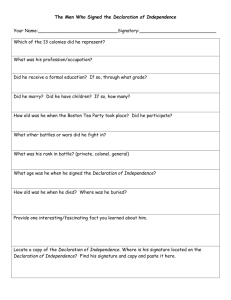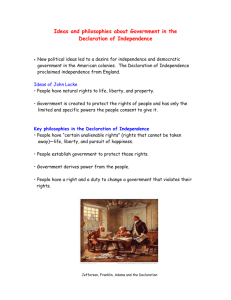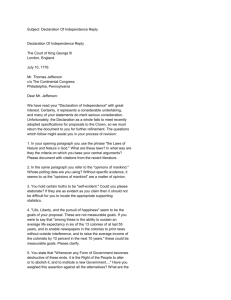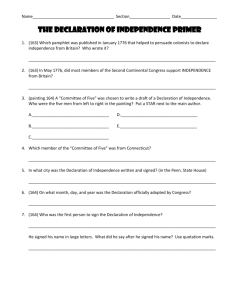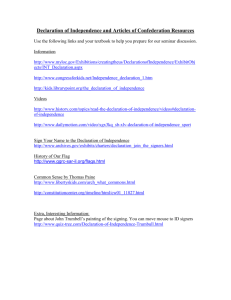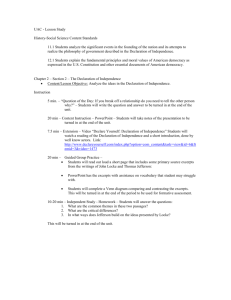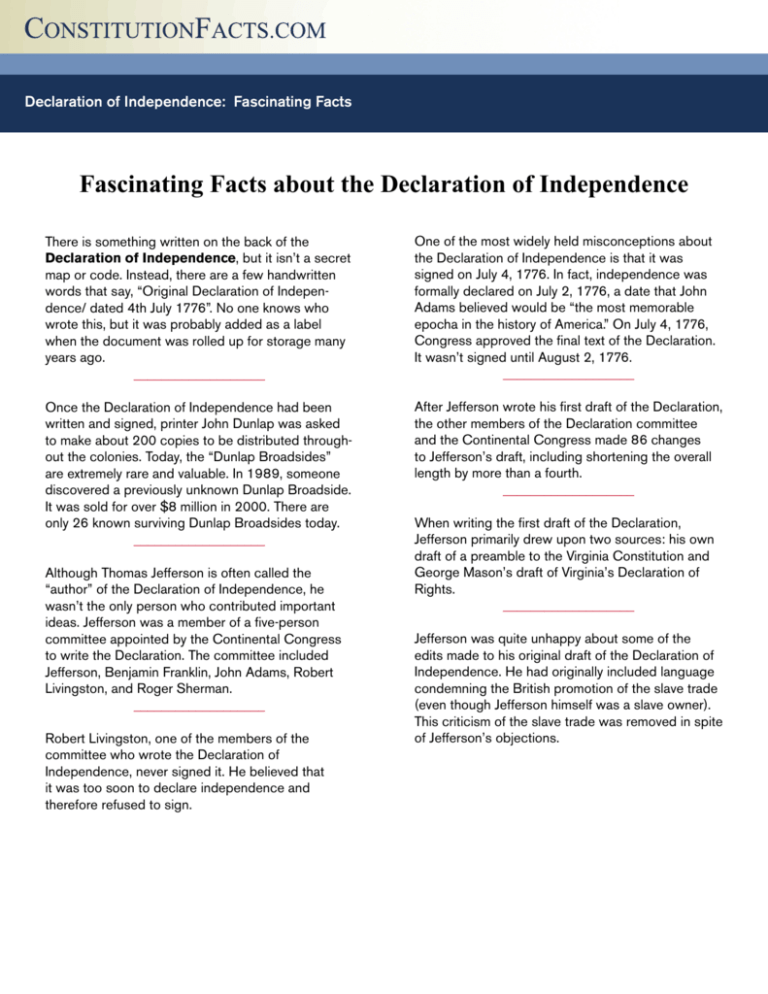
Declaration of Independence: Fascinating Facts (Continued)
Fascinating Facts about the Declaration of Independence
There is something written on the back of the
Declaration of Independence, but it isn’t a secret
map or code. Instead, there are a few handwritten
words that say, “Original Declaration of Independence/ dated 4th July 1776”. No one knows who
wrote this, but it was probably added as a label
when the document was rolled up for storage many
years ago.
___________________
One of the most widely held misconceptions about
the Declaration of Independence is that it was
signed on July 4, 1776. In fact, independence was
formally declared on July 2, 1776, a date that John
Adams believed would be “the most memorable
epocha in the history of America.” On July 4, 1776,
Congress approved the final text of the Declaration.
It wasn’t signed until August 2, 1776.
___________________
Once the Declaration of Independence had been
written and signed, printer John Dunlap was asked
to make about 200 copies to be distributed throughout the colonies. Today, the “Dunlap Broadsides”
are extremely rare and valuable. In 1989, someone
discovered a previously unknown Dunlap Broadside.
It was sold for over $8 million in 2000. There are
only 26 known surviving Dunlap Broadsides today.
___________________
After Jefferson wrote his first draft of the Declaration,
the other members of the Declaration committee
and the Continental Congress made 86 changes
to Jefferson’s draft, including shortening the overall
length by more than a fourth.
___________________
Although Thomas Jefferson is often called the
“author” of the Declaration of Independence, he
wasn’t the only person who contributed important
ideas. Jefferson was a member of a five-person
committee appointed by the Continental Congress
to write the Declaration. The committee included
Jefferson, Benjamin Franklin, John Adams, Robert
Livingston, and Roger Sherman.
___________________
Robert Livingston, one of the members of the
committee who wrote the Declaration of
Independence, never signed it. He believed that
it was too soon to declare independence and
therefore refused to sign.
When writing the first draft of the Declaration,
Jefferson primarily drew upon two sources: his own
draft of a preamble to the Virginia Constitution and
George Mason’s draft of Virginia’s Declaration of
Rights.
___________________
Jefferson was quite unhappy about some of the
edits made to his original draft of the Declaration of
Independence. He had originally included language
condemning the British promotion of the slave trade
(even though Jefferson himself was a slave owner).
This criticism of the slave trade was removed in spite
of Jefferson’s objections.
Declaration of Independence: Fascinating Facts (Continued)
On December 13, 1952, the Declaration of
Independence (along with the Constitution and Bill
of Rights) was formally delivered to the National
Archives in Washington, D.C., where it has remained
since then.
___________________
The two youngest signers of the Declaration of
Independence were both from South Carolina.
Thomas Lynch, Jr. and Edward Rutledge of South
Carolina were both born in 1749 and were only 26
when they signed the Declaration. Most of the other
signers were in their 40s and 50s.
___________________
Philosopher John Locke’s ideas were an important
influence on the Declaration of Independence.
Thomas Jefferson restated Locke’s contract theory
of government when he wrote in the Declaration that
governments derived “their just Powers from the
consent of the people.”
___________________
Thomas Jefferson and John Adams both died on July
4, 1826, the 50th anniversary of the vote to approve
the Declaration of Independence.
___________________
Some of the most famous lines in the Declaration
of Independence were inspired by Virginia’s Declaration of Rights by George Mason. Mason said:
“all men are born equally free and independent.”
Jefferson’s Declaration of Independence said: “We
hold these truths to be self-evident, that all men are
created equal.” Mason listed man’s “natural Rights”
as “Enjoyment of Life and Liberty, with the Means
of acquiring and possessing Property, and
pursuing and obtaining Happiness and Safety.”
Jefferson listed man’s “inalienable rights” as “Life,
Liberty, and the Pursuit of Happiness.”
Nine of the signers of the Declaration died before
the American Revolution ended in 1783.
___________________
In the summer of 1776, when the Declaration was
signed, the population of the nation is estimated to
have been about 2.5 million. (Today the population
of the U.S. is more than 300 million.)
___________________
The oldest signer of the Declaration was Benjamin
Franklin, who was born in 1706 and was therefore
already 70 at the time of the Declaration. Franklin
went on to help negotiate the Treaty of Alliance with
France in 1778 and the Treaty of Paris, which ended
the Revolutionary War in 1783.
___________________
The only signer of the Declaration of Independence
to survive beyond the 50th anniversary of the signing was Charles Carroll of Maryland. Carroll died in
1832 when he was 95 years old.
___________________
The copy of the Declaration of Independence that
is housed at the National Archives is not the draft
that was approved by the Continental Congress on
July 4, 1776. Instead it is a formal copy that the
Continental Congress hired someone to make for
them after the text was approved. This formal copy
was probably made by Timothy Matlack, an assistant
to the Secretary of Congress. This copy was signed
on August 2, 1776.
2
Declaration of Independence: Fascinating Facts (Continued)
No one who signed the Declaration of Independence was born in the United States of America.
The United States didn’t exist until after the
Declaration was signed! However, all but eight
of the signers were born in colonies that would
become the United States.
___________________
The first public reading of the Declaration took place
on July 8, 1776, in Philadelphia. A fictional story
written in the 1840s suggested that the bell now
known as the Liberty Bell was rung that day to bring
the people together. However, historians now doubt
that this happened. The steeple that housed the bell
was in very bad condition at the time and the bell
was probably unusable.
___________________
Although August 2, 1776, was the date of the official
signing ceremony, there were several people who
signed on later dates. Some of these late signers
included Elbridge Gerry, Oliver Wolcott, Lewis
Morris, Thomas McKean and Matthew Thornton.
To learn more about the Constitution — the people, the events, the landmark cases —
order a copy of “The U.S. Constitution and Fascinating Facts About It” today!
Call to order: 1-800-887-6661 or order online at www.constitutionfacts.com
© Oak Hill Publishing Company. All rights reserved.
Oak Hill Publishing Company. Box 6473, Naperville, IL 60567
3


